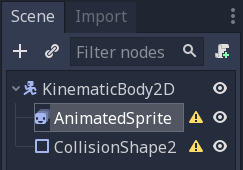2D Sprite animation¶
Introduction¶
In this tutorial, you’ll learn two different ways to create 2D animated characters. Typically, when you create or download an animated character, it will come in one of two ways: as individual images or as a single sprite sheet containing all the animation’s frames. Depending on which type of assets you have, you can choose one of the following solutions.
First, we’ll use AnimatedSprite to animate a collection of individual images. Then, to use a sprite sheet, we’ll use AnimationPlayer along with the Animation property of Sprite.
Note
Art for the following examples by https://opengameart.org/users/ansimuz
Individual images with AnimatedSprite¶
In this scenario, you have a collection of images, each containing one of your character’s animation frames. For this example, we’ll use the following animation:

You can download the images here:
run_animation.zip
Unzip the images and place them in your project folder. Set up your scene tree with the following nodes:

Note
The root node could also be Area2D or RigidBody2D. The animation will still be made in the same way. Once the animation is completed, you can assign a shape to the CollisionShape2D. See Physics Introduction for more information.
Now select the AnimatedSprite and in its SpriteFrames property, select
“New SpriteFrames”.
Click on the new SpriteFrames resource and you’ll see a new panel appear at the bottom of the editor window:
From the FileSystem dock on the left side, drag the 8 individual images into the center part of the SpriteFrames panel. On the left side, change the name of the animation from “default” to “run”.
Back in the Inspector, check the box for the Playing property. You should now see the animation playing in the viewport. However, it is a bit slow. To fix this, change the Speed (FPS) setting in the SpriteFrames panel.
You can add additional animations by clicking the “New Animation” button and adding additional images.
Controlling the animation¶
Once the animation is complete, you can control the animation via code using
the play() and stop() methods. Here is a brief example to play the
animation while the right arrow key is held, and stop it when the key is
released.
extends KinematicBody2D
func _process(delta):
if Input.is_action_pressed("ui_right"):
$AnimatedSprite.play("run")
else:
$AnimatedSprite.stop()
Sprite sheet with AnimationPlayer¶
In the event you have a sprite sheet containing all of your animation frames,
you can’t easily use AnimatedSprite. Instead, you can use a standard
Sprite node to display the texture, and then animate the
change from texture to texture with AnimationPlayer.
Consider this sprite sheet, which contains 6 frames of animation:

Right-click the image and choose “Save Image As” to download, then copy the image into your project folder.
Our goal is to display these images one after another in a loop. Start by setting up your scene tree:

Note
The root node could also be Area2D or RigidBody2D. The animation will still be made in the same way. Once the animation is completed, you can assign a shape to the CollisionShape2D. See Physics Introduction for more information.
Drag the spritesheet into the Sprite’s Texture property, and you’ll see the
whole sheet displayed on the screen. To slice it up into individual frames,
expand the Animation section in the Inspector and set the Hframes to 6.
Hframes and Vframes are the number of horizontal and vertical frames in
your sprite sheet.

Now try changing the value of the Frame property. You’ll see that it ranges
from 0 to 5 and the image displayed by the Sprite changes accordingly.
This is the property we’ll be animating.
Select the AnimationPlayer and click the “Animation” button followed by
“New”. Name the new animation “walk”. Set the animation length to 0.6 and
click the “Loop” button so that our animation will repeat.

Now select the Sprite node and click the key icon to add a new track.

Continue adding frames at each point in the timeline (0.1 seconds by
default), until you have all the frames from 0 to 5. You’ll see the frames
actually appearing in the animation track:

Press “Play” on the animation to see how it looks.

Summary¶
These examples illustrate the two most common situations you’ll encounter in
2D animation. Each has its benefits. Working with AnimationPlayer is
a bit more complex, but provides additional functionality, since you can also
animate other properties like position or scale. Experiment and see which
works best for your needs.